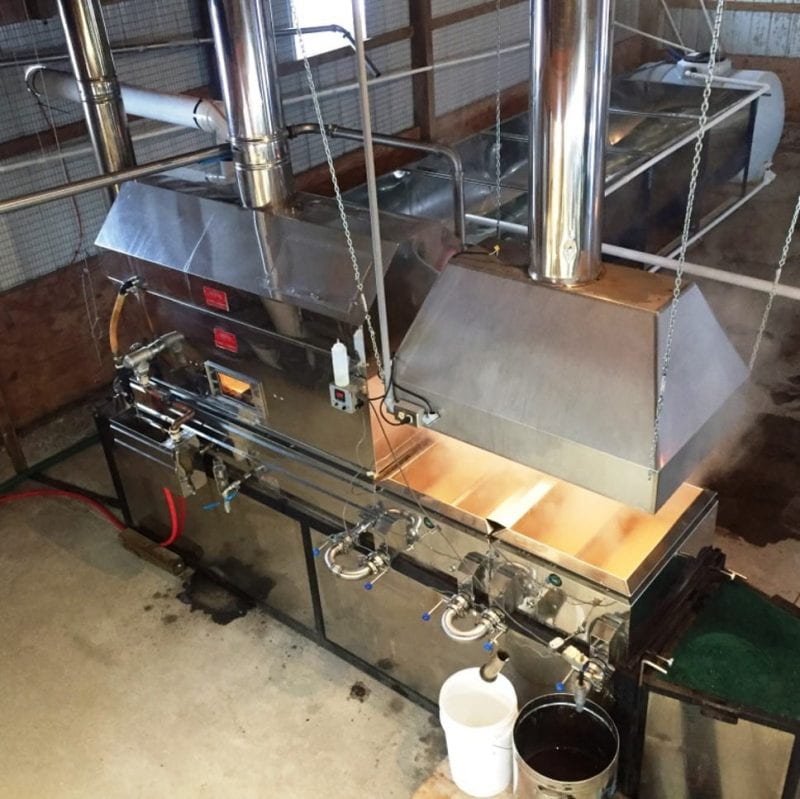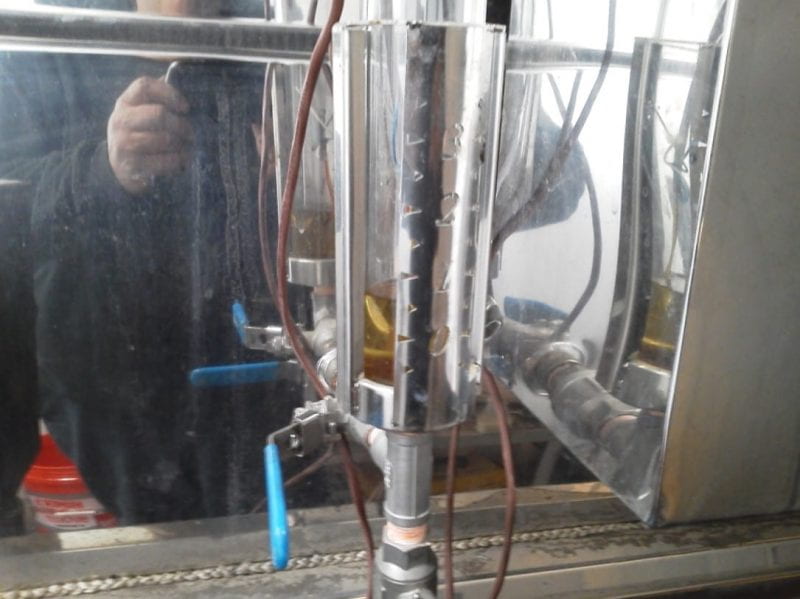A Simple Yet Complex Process
Many producers refer to boiling as the art of making maple syrup. Boiling on a modern evaporator is a process requiring about 45 minutes to move from the inlet at the start to the draw-off at the finish. Bringing 2% sap through a float at the back of the machine and moving the sap forward through a series of channels until it reaches 66 Brix at the opposite end may sound quite simple; however, properly boiling syrup is a very complex scientific process based on physics, chemistry and microbiology.
To meet USDA Standards, maple syrup must be at least 66 percent sugar. This is referred to as syrup density which is measured in Brix. Brix is a measurement scale based on the percentage of sugar in a sample. Because Syrup is made up of over 98% Sucrose sugar, we simply define the density of maple syrup as percent sugar. In this case, 66 Brix syrup would be 66 percent sugar. Once we know the percentage of sugar in sap, we can determine the amount of sap that it takes to make a gallon of syrup. To do this we apply a simple formula – the “Jones Rule of 86” – where you take the factor of 86 and divide it by the percent sugar to obtain the number of gallons of sap required to make one gallon of syrup. For example, 86 divided by 2% sugar content sap equals 43 gallons of sap to produce one gallon of syrup.
You can start to see how chemistry and a little math plays a role in converting sap to syrup. What about physics? When sap is boiling, a gradient is formed causing the heavy syrup to move in front of the lower density sap. If the pan on the evaporator is boiling, then the two will not mix unless you suddenly lower the temperature in one section of the pans. Disrupting the boil results in an intermingling of sap temperatures which causes a drop in boiling intensity. The result is the dreaded big batch and improper syrup density.
Microbiology comes in to play when colonies of microbes begin to increase. Lack of microbial sanitation is the most common reason for the darkening of syrup potentially resulting in an off flavor. Microbial action changes the sucrose to invert sugars (glucose and fructose). As the percentage of invert sugar increases, heat causes syrup color to darken. It is possible to darken the syrup to a level where the color and flavor are severely impacted. If you ignore any or all of the science involved, you could end up with something that you will definitely not want to put on your own table let alone sell to your neighbor.
Managing Your Flue Pan
The flue pan is where all the heavy lifting of the boiling process is done. There are two basic types of modern evaporators, raised flue and drop flue. The level of sap in a pan is controlled by a float box. With a drop flue, you only have one float box controlling the depth of the sap throughout the entire machine. The sap level is maintained at 1.5-2 inches from back to front. Two inches depth is a safe starting point for beginners. Any change you make to the float at the back of the evaporator will be transferred forward to the draw-off point. Thus, all changes should be minimal and incremental. A raised flue evaporator has two floats, one for the back pan or flue pans and one for the front pan or syrup pans. Though you are still running just one evaporator, you can control two separate processes. The double float design allows you to run your depth in the back pan at 1 inch while running the front pan between 1.5-2 inches. The dual control increases evaporator efficiency, more rapidly boils off water, and better controls the draw-off process. The shallower you can run the back pan the more heat you transfer into the sap and the harder the boil. If you run your back pan too deep, the boil slows, and efficiency is reduced.

Raised Flue Evaporator with device to evacuate away steam from boiling process.
Which style of evaporator you prefer is strictly a personal preference. And once you learn your evaporator’s sweet spot, once the depth is set, you can generally leave it alone. All evaporators should have at least one sap level gauge on the flue pan (raised flue evaporators should have a second gauge between the two front pans). A properly calibrated gauge allows you to know the exact sap level no matter if the flue pan is hooded or clouded with steam.

Drop Flue Evaporator with reverse front flow pan.
When running your evaporator, the basic goal is to maintain a boil across the entire rig with the hardest boil occurring in the flue pan. There is an old saying among maple producers, “You haven’t earned your producer’s badge until you have burnt a pan.” Trust me if you have never scorched a pan, or come close to burning one, consider yourself lucky. Usually the most common reason for burning a pan is human error, usually caused by a distraction. When you are running a rig, you are dealing with extreme heat. Stack temperatures can run between 600-1000 degrees F. You are applying that heat to a relatively small skinny volume of liquid (2 inches spread across the surface of the pan) separated by a thin layer of stainless steel. The only thing that keeps that metal from melting is the thin layer of sap on top. If the sap boils out because you forgot to turn on a valve or you ran out of sap, bad things happen very quickly. Uncontrolled high temperatures can go from a scorch to buckling a pan in just a few short minutes. Your season could be over if you cannot find a replacement.
Tracking bubbles in your sap is a good way to monitor your boil. The bubbles in the pan should be moving slowly in one direction toward the draw-off. If the boil decreases and the bubbles move back and forth then an adjustment needs to be made immediately. If you spot trouble the first thing you must do is avoid panic. Move quickly and precisely. This is where knowing what to expect and what to do is vital and that only comes with experience.
Stay tuned for Part II next week!
Author: Les Ober, Geauga County OSU Extension 






